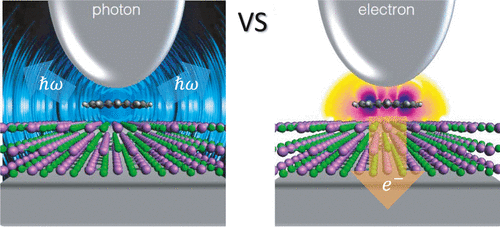当前位置:
X-MOL 学术
›
ACS Photonics
›
论文详情
Our official English website, www.x-mol.net, welcomes your
feedback! (Note: you will need to create a separate account there.)
Effect of a Dielectric Spacer on Electronic and Electromagnetic Interactions at Play in Molecular Exciton Decay at Surfaces and in Plasmonic Gaps
ACS Photonics ( IF 6.5 ) Pub Date : 2021-11-16 , DOI: 10.1021/acsphotonics.1c00791 Fernando Aguilar-Galindo 1, 2 , Mario Zapata-Herrera 3 , Sergio Díaz-Tendero 1, 4, 5 , Javier Aizpurua 2, 3 , Andrei G. Borisov 6
ACS Photonics ( IF 6.5 ) Pub Date : 2021-11-16 , DOI: 10.1021/acsphotonics.1c00791 Fernando Aguilar-Galindo 1, 2 , Mario Zapata-Herrera 3 , Sergio Díaz-Tendero 1, 4, 5 , Javier Aizpurua 2, 3 , Andrei G. Borisov 6
Affiliation

|
The deposition of individual molecules, molecular networks, and molecular layers at surfaces is at the core of surface reactivity, energy harvesting, molecular electronics, and (single) photon sources. Yet, strong adsorbate–substrate interaction on metallic surfaces quenches the excited molecular states and harms many practical applications. Here, we theoretically address the role of a NaCl ionic crystal spacer layer in decoupling an adsorbate from the substrate and therefore changing the interplay between the competing decay channels of an excited molecule driven by electronic and electromagnetic interactions. A quantitative assessment of the corresponding decay rates allows us to establish the minimum thickness of the spacer required for the observation of molecular luminescence from the junction of a scanning tunneling microscope. Our work provides a solid quantitative theoretical basis relevant for several fields of nanotechnology where engineering of ionic crystal spacers allows for adsorbate charge manipulation, reactivity, and photon emission in nanocavities.
中文翻译:

介电间隔物对表面分子激子衰变和等离子体间隙中电子和电磁相互作用的影响
单个分子、分子网络和分子层在表面的沉积是表面反应性、能量收集、分子电子学和(单)光子源的核心。然而,金属表面上强烈的吸附质 - 底物相互作用会淬灭激发分子状态并损害许多实际应用。在这里,我们从理论上解决了 NaCl 离子晶体间隔层在将被吸附物与基底分离并因此改变由电子和电磁相互作用驱动的激发分子的竞争衰变通道之间的相互作用中的作用。对相应衰减率的定量评估使我们能够确定从扫描隧道显微镜的结点观察分子发光所需的间隔物的最小厚度。
更新日期:2021-12-15
中文翻译:

介电间隔物对表面分子激子衰变和等离子体间隙中电子和电磁相互作用的影响
单个分子、分子网络和分子层在表面的沉积是表面反应性、能量收集、分子电子学和(单)光子源的核心。然而,金属表面上强烈的吸附质 - 底物相互作用会淬灭激发分子状态并损害许多实际应用。在这里,我们从理论上解决了 NaCl 离子晶体间隔层在将被吸附物与基底分离并因此改变由电子和电磁相互作用驱动的激发分子的竞争衰变通道之间的相互作用中的作用。对相应衰减率的定量评估使我们能够确定从扫描隧道显微镜的结点观察分子发光所需的间隔物的最小厚度。











































 京公网安备 11010802027423号
京公网安备 11010802027423号